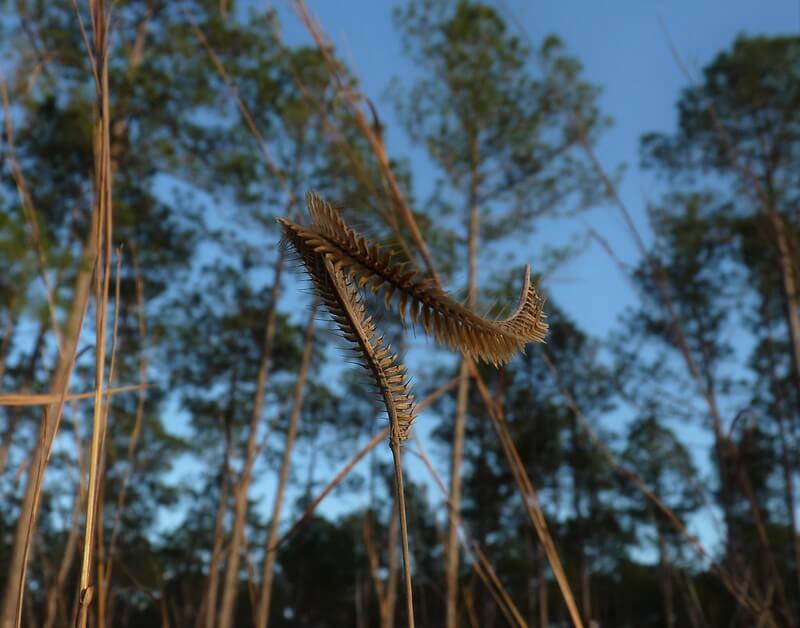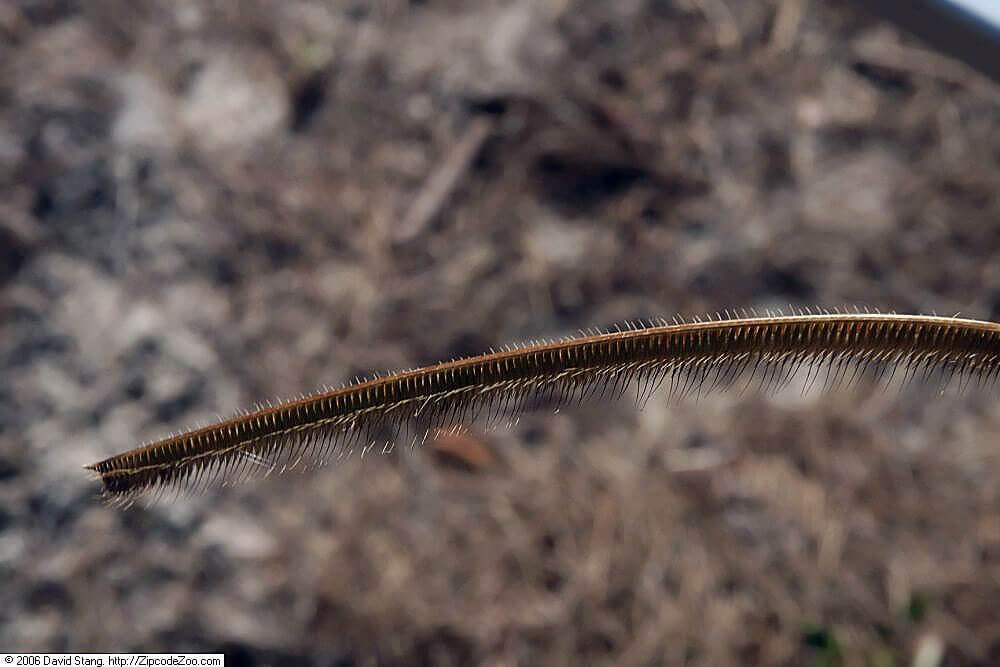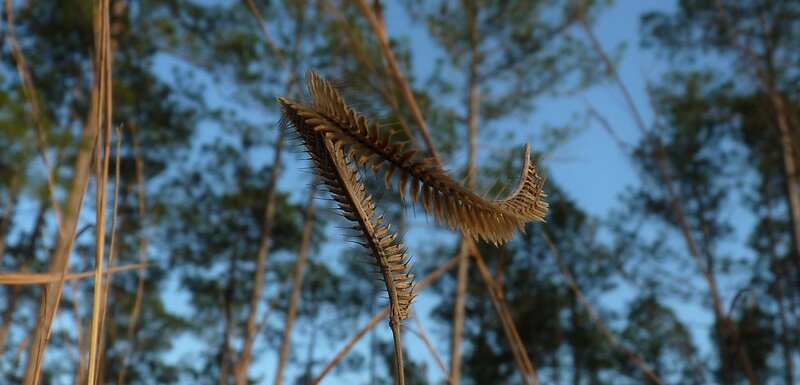If you live in the Southeastern United States, you may be familiar with a unique endemic plant. Toothache grass has been used for many centuries to help alleviate local aches and pains associated with toothaches (as the name implies).
It is fire dependent, and it thrives (and can only be found) in fire-maintained environments with a special preference for longleaf pine wiregrass ecosystems in the coastal plain. This lovely plant is closely associated with areas that have seasonal inundation, and can be found in and around wetlands and bogs, particularly places with acidic soil.
Toothache grass, (Ctenium aromaticum) is a genus of perennial grass in the true grass family, Poaceae. As mentioned, it is found in the Southeastern United States, however, there are about 20 types of toothache grass found in Africa and the New World.
As the name implies, toothache grass has been specifically used to treat toothaches, and alleviate pain. In Africa, toothache grass can be quite common in grazed areas and is often used to treat pain associated with bee stings and dog bites. Stateside, it isn’t commonly used at all. Mostly because it isn’t commonly found and its medicinal benefits are not well known.
How to Identify Toothache Grass
It’s a fun, twisted, curly-topped grass that generally grows about 2 to 6 feet tall (think hay in height, diameter, and color). Honestly, just check out the photos. We could go into the technicalities of toothache grass inflorescence, but one look at a photo and you’ll know it when you see it.
If you endeavor to crush the roots (instead of directly chewing them), you’ll find they have a rather potent scent.
And if you’re curious to catch this plant in flower, it generally does so in a June to August timeframe.
How to Use Toothache Grass

Generally, the most popular method is to pull the plant by the base of the stem, being careful not to break the connection between the base and thick tuber root. The root is the most potent part and is most desirable to produce the wanted effects. However, some have found the lower stem to be effective as well. That way, there’s more of the entire plant to use rather than just the bottom.
Because of the way toothache grass is used, the entire plant has to be uprooted and killed in order to receive the medicinal value. This is another reason it is hard to find. People are going into areas with known populations and taking all they see. Please be mindful of over harvesting.
Processing of this plant is to pull up the tubers and cut off the top of the stem, preserving the bottom and tubers. I would also recommend peeling away the top layer sheath of the stem, and of course, to wash the tuber that has been buried in the ground.
The last part of this process is up to you: Dry it, powderize, chew it fresh, chop it, and incorporate it into your personal tonic or tea, make tinctures, grind it up and place in capsules — whatever! The choice is yours.
My favorite is simply chewing the tubers. My second favorite is getting new friends to try it. It’s always comical to see their reactions to the tingly sensation.
I have also found that some like to incorporate toothache grass tubers (in a powder or paste) with homemade deodorant, toothpaste, or shampoo. The added tingle effect makes these products feel like they’re working, and adds a nice relaxing feel to the process.
If you’re interested in establishing wild grasses on your homestead, it is an excellent choice for that — even if you aren’t keen on the medicinal uses. Toothache grass will attract birds and butterflies onto your property, if you want to incorporate wildlife habitat.
Fun Fact: In Africa, the top part of the stems is often used to create roof thatching.
Benefits of Toothache Grass
As already explained, this plant is useful in helping with toothaches. It can also greatly reduce the sensation of a sore throat.
Toothache grass can be particularly helpful if you’re experiencing what some people like to refer to as cottonmouth (dry mouth) as it is often used as a sialagogue (an agent that increases saliva). I can attest from personal experience that this plant causes a strong numbing sensation and an excess production of saliva.
Now, to get into the “How?” of it. Toothache grass contains three natural anesthetics: pellitorine, dodecadienamide, and isoaffinin. These anesthetics are also referred to as tingle molecules — a name I personally like better.
Pellitorine has long served in traditional medicine to treat toothaches. Beyond this, pellitorine has been found to have beneficial effects to enhance male performance and testosterone levels, and counter bug bite ailments and bacteria.
Dodecadienamide and isoaffinin have been used in traditional medicine for the specific purpose of dentistry work and oral medications. Isoaffinin has even been placed in chewing gum, oral products, colognes, and some topical cosmetics for the tingling and soothing sensation it produces.
Be Environmentally Conscious When Harvesting Toothache Grass
Given its very characteristic appearance, if you’ve seen it before, you’ll immediately recognize it. When I was in school and learned about toothache grass, my professor emphasized conservation-minded awareness. To paraphrase:
Yes, this is a cool species, but we don’t teach about it until you’re a couple years into your degree and better able to understand conservation because if a bunch of excited folks who don’t care about conservation know about this species, they’ll likely come out to these small areas where it’s found and harvest way too much, hurting the local populations and wiping out the species.
With that problem addressed, I would strongly advise you to be environmentally conscious if you’re ever harvesting toothache grass. Go by Robin Kimmerer’s approach from her book “Braiding Sweetgrass.” Don’t take the first plant you see, because it may be the only one. If you find more, take less than half of what is locally available. Then wait a growth season or more before returning. If you desire more than the amount this method offers, find other spots to harvest, or consider cultivating your own.
Fun (but sad) Fact: Because of fire suppression, clearcutting, urban development, and soil disturbances, toothache grass is declining. Again, be conservation minded. I felt torn about writing this article, but I believe increased awareness can help re-establish it, especially if people are interested in growing it on their homestead.

Cultivating your own is a grand idea, as it helps re-establish a fun and beautiful plant species. It can be rather easy to grow, if conditions are right (it prefers sandy soils). I have included general habitat characteristics here, but if you’re interested in growing it yourself, read up on more specific habitat needs.
With that said, if you have areas on your homestead with acidic soils, seasonal inundation, wetland edges, or longleaf pine-wiregrass ecosystems, they can be the perfect place to grow toothache grass. Also keep in mind that the reason this plant is fire dependent is because seeds are only produced after a region has been exposed to fire. So create an extremely small burn plot around it and seasonally burn the area (research this, too).
You can order seeds online (it’s unlikely you’ll find them in a local store, but try anyway just to see). If you’re purchasing seeds, make sure the scientific name matches (Ctenium aromaticum).









































Leave a Reply